I once read a post Gizmodo wrote a post about the Makanyane Safari Resort. There was one photo of a large elephant standing right outside the lodge window. I was sold. I made it a priority to stop here on my epic world trip a few years ago where I attempted to capture 15 countries with my iPhone 4s.
Day 2
At 5am, my brief, Bourne Identity dream, in which I play Matt Damon’s awesome krav maga trained BFF is abruptly interrupted by knock at the door. Uh. Thanks. Now we’ll never know who the baddies are.
I look outside and it’s still pitch black. Maybe I’ll just sleep a few more minutes… Knock, knock, knock. I see the hint of daybreak and suddenly realize I’m not a secret spy trying to uncover an onion-layered conspiracy or Matt Damon’s BFF, but a photographer trying to capture the majesty of South Africa with an iPhone. Not an easy mission, but I’m up for the challenge. Right after I down these five cups of tea and a red bull. Caffeine always tastes sweeter at 5:30am.
My safari group including the Aussie family is a little sluggish as we set off. I call shot-gun, as my back was not happy with me from the 4 hour ride in the very back hump of the jeep the day before. The air is slightly chilly, so I bundle up in a blanket. The tips of the trees are slowly coated in a warm golden light and we start spotting creatures.
“Mongoose,” Dylan exclaims. I squint and see something dart into the bush by the side of the road. Disappointed I was unable capture a shot of the elusive mongoose, I slump into my hard vinyl seat and glance towards the tree line.
“Elephant!” The Aussie mum calls out.
“Mum that’s a tree trunk,” the older brother smugly replies. Everyone laughs. The jeep turns the corner, and we are meters away from a very large elephant. “Well spotted mum!” Smugness drains from his face, replaced by sincere amazement.

“He’s a big boy!” Dylan’s eyes narrow. His corners of his begin to twitch as the bull starts to move towards us with his ears extended. He does not look impressed. With one damaged tusk, this guy looks like he might have some anger management issues. He raises his truck and continues to push forward. I am furiously snapping shots, having no sense of the impending danger of an angry bull protecting his young.
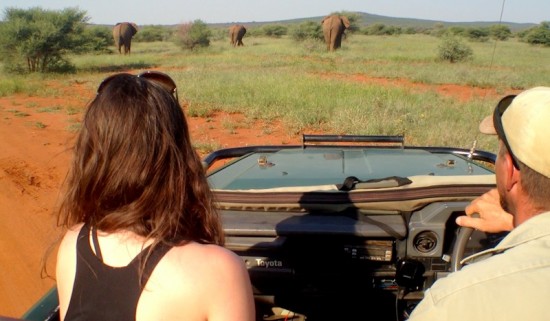
The bull opens his mouth and widens his ears. Dylan senses danger and slams on the gas, throwing us into reverse as we veer off the path into the bush. “Duck,” he yells. Vicious bushes with needle-like spires come within inches of my face, slightly grazing my arm.

We escape narrowly as another herd approaches and nearly 50 elephants cross in front of us.

The day is quickly fading and the sky floods with a rich, burnt orange colour. Dylan stops the jeep and the silence of our surroundings is arrested by a loud smacking and crunching sound. I let my gaze drift up beyond the tree line and see a mother and baby giraffe tucking into a delicious dinner of organic leafy greens.
I know this could be a great shot, but with limited light, I know that I’m severely limited with my iPhone. I quickly grab my tripod and prop it up on the side of the jeep to gain some stability. As I set up my frame, baby giraffe lowers his head out of my shot. I knew he wouldn’t play nice. Let the waiting game begin.
Crickets chirp, furry creatures scurry pass, my mind regresses to thoughts about Matt Damon… Then, suddenly, baby and mama lift and turn their heads in perfect unison and for one second there was a perfect shot. Snap.
Day 3
The jeep stops and Dylan hops out. “Drink time,” he announces. He plops a wooden table on the dusty road a few meters from about a hundred wild animals.

I jump out and start frantically grabbing shots of the zebras with my iPhone using the telephoto lens. The distance is fixed, but the focus is not. It requires a lot of fiddling to get a sharp image and the zebras are not cooperating. They are slowly moving further away as the rest of the safari group collects around the snacks of dried, jerky-like meat called biltong.
The enthusiastic Aussies coax me into trying a random spicy chunk o’ something. It takes me about 5 minutes to chew through it. It is… gamey :)

The sun starts to set over the plain, and I go in search for a lonely tree. Most photographers will have a very clear idea of certain bucket list shots they want to take in their life. For me, one of those is Alessandra Ambrosio in a hot pink bikini on a deserted beach in the Caribbean and another is a silhouetted gnarly tree in front of an epic sunset. Since Alessandra never returns my calls, I opt for the lonely tree.
I spot an epic tree and rush towards it, but Dylan calls out, “I wouldn’t get too far from the jeep. We don’t know what are hiding in those bushes.” He seems serious and starts listing off various poisonous snakes, so I start scouting for another lonely tree closer to the jeep. I find a smaller one which I shall dub “the mini lonely tree”. Not my bucket list shot, but a nice shot. I guess a nice safe shot is better than a great one involving a tangle with a puffheader snake.

As we pack up to leave, the jeep’s intercom sounds. Bzzzrrrt. Dylan starts frantically returning call signs of animals with another guide using the Bantu language, Tswana, instead of English. The guides use this communication barrier to keep tourists guessing what animals they will see on the drive. Over the past few days I’ve tried to learn several Tswana words so I could decode this guide banter, but I don’t recognize any words this time.
Dylan explains that another jeep ahead of us has seen a rare sighting of makanyane, the endangered wild dog of South Africa. There are only two packs on the 750K hectare Madikwe reserve after one pack was eaten by lions, so it’s rare to see them. Dylan excitedly speeds across the plains to the sighting location.
As we turn a sharp corner, we see pack of makanyane gliding along the dusty red trail in front of us. They are shaggy, boney creatures that look like a cross between a dog and a hyaena. Ears perked high and a determined gait, these dogs take no notice of us apart from a few yips of acknowledgement from the alpha male.
They are fast and focused. Sundown is hunting time, and as both predators and prey, surviving the long night ahead will require a united pack. Their pace increases and they begin to move towards the edge of the road, forming a tightly synced unit. Ten seconds later the pack darts into the bush, vanishing into the vast reserve. It could be weeks or months before they are seen again and their survival is known.
That’s the cycle of life out here: Brutal, beautiful, and bewildering. Something we can only witness as humans, but perhaps never fully understand.
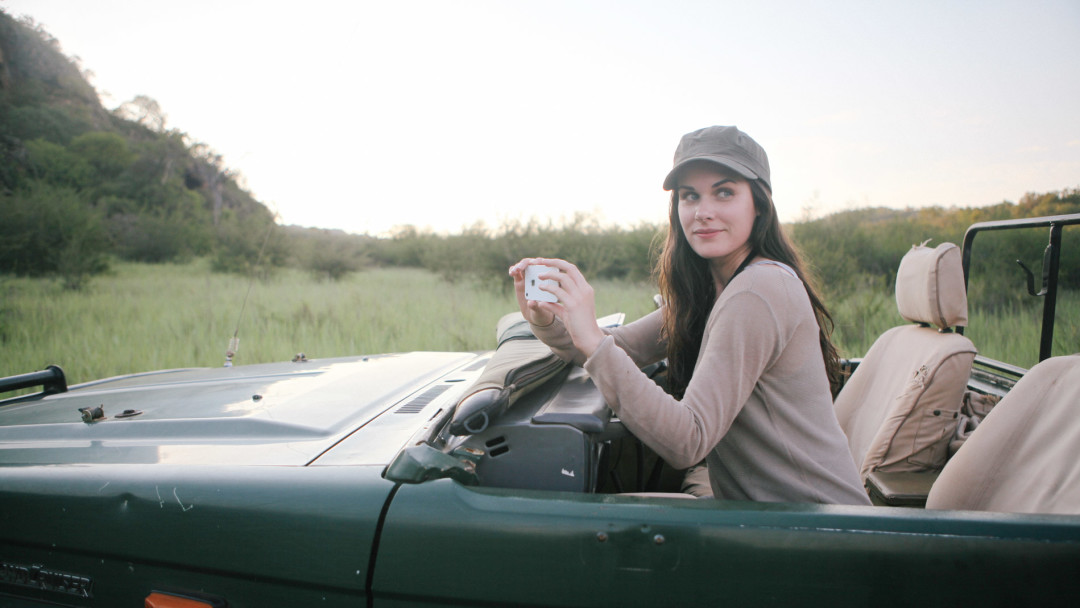
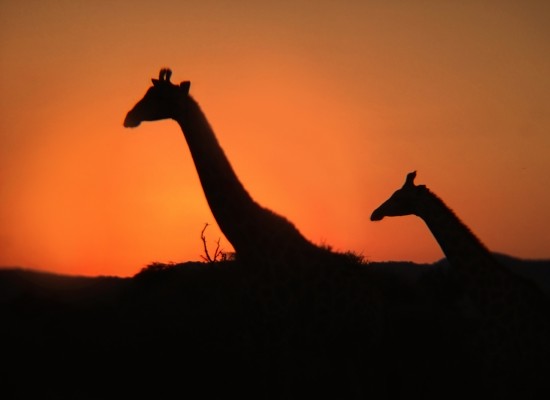

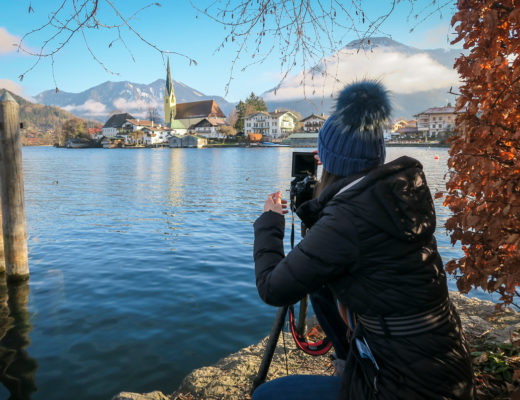
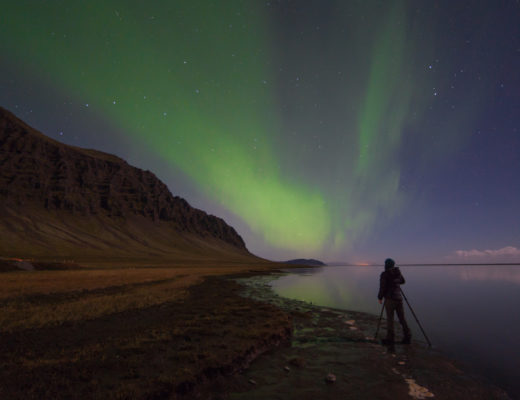
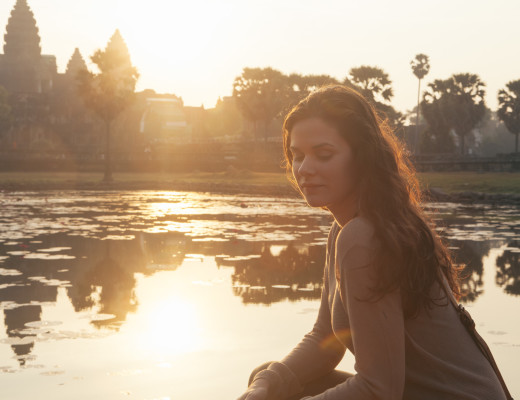
Around the World with an iPhone: South African Safari – Mostly Lisa | Photography tips & inspiration
May 18, 2016 at 1:04 PM[…] Read more safari adventures. […]